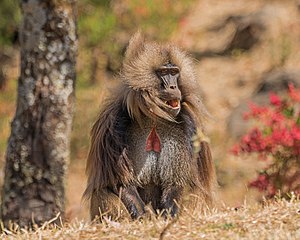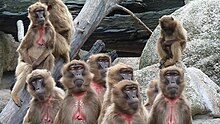Gelada
| Gelada | ||||||||||||
|---|---|---|---|---|---|---|---|---|---|---|---|---|

Gelada ( Theropithecus gelada ) |
||||||||||||
| Systematics | ||||||||||||
|
||||||||||||
| Scientific name of the genus | ||||||||||||
| Theropithecus | ||||||||||||
| I. Geoffroy Saint-Hilaire , 1843 | ||||||||||||
| Scientific name of the species | ||||||||||||
| Theropithecus gelada | ||||||||||||
| ( Rüppell , 1835) |

The Gelada or Blood Breast Baboon ( Theropithecus gelada ) is a very rare species of primate from the subfamily of cheekbones monkeys in the family of vervet monkeys . It is closely related to the baboons .
description
The most noticeable feature of the jeladas is a red, hairless patch on the chest. This is hourglass-shaped in males and bright red in the rutting season, in females a row of red warts forms there during oestrus . The animals have a brown fur that is lighter on the underside. The snout is rounded and differs from that of baboons by the lateral nostrils. Dscheladas reach a head body length of 50 to 75 centimeters, the tail becomes as long as the body and ends in a tassel. With a weight of up to 21 kilograms, the males are considerably larger than the females, who only reach around 14 kilograms, and the males also have an impressive mane.
distribution and habitat
Jeladas only inhabit the highlands of Ethiopia . Their habitat is mountainous grassy areas at an altitude of 2200 to over 4400 meters above sea level.
Way of life
Jeladas are pure ground dwellers, to sleep they retreat into crevices or narrow gorges, and spend the day looking for food on the flat areas.
Dscheladas live in two different group types: On the one hand, there are groups made up of a sexually mature male, several females and their offspring, and on the other hand, pure male groups consisting primarily of young animals. Sometimes, however, an older specimen that was driven away from a mixed group is also found in these groups of males. In contrast to the baboons, females lead the group with the jeladas. They also choose their males. If a male animal wants to drive away another from a mixed group, they first fight. Regardless of the outcome of this dispute, the females have already made their choice and will drive away the unwanted male. Jeladas have no territorial behavior: when there is plenty of food, several groups form associations that can comprise more than 300 people. However, social interaction and mutual grooming only happen within the small group, animals from unfamiliar groups hardly pay any attention to one another.
When communicating, Dscheladas make varied, smacking sounds that scientists interpret as being similar to languages.
nutrition
Geladas are the only primates that feed mostly on grass and grass seeds. Their diet, however, varies with the seasons: in the rainy season, when there is an abundance of grass, this is their only food, in the dry season they also rely on roots and tubers. Their thumbs are very flexible and so they can skillfully grab individual stalks.
The species Theropithecus brumpti ( 4.0-2.5 million years ago) and Theropithecus oswaldi ( 2.0-1.0 million years ago), which have been handed down to fossil fuels in Kenya , were mainly fed by such relatively hard C 4 plants .
Reproduction
Geladas do not have a distinct mating season. The fertility of the female is shown by the fact that her breast spot glows red and her vulva swells. The impulse to mate comes from the females and is synchronized so that almost all females in the group give birth to their offspring at the same time. The gestation period lasts around five to six months. Young animals are suckled for around a year and a half. Since the nipples are very close together, a unique anatomical feature of the females, the young can suckle on both breasts at the same time.
Females reach sexual maturity at 4 to 5 years and males at 5 to 8 years. The life expectancy of these animals is over 20 years.
Threat and protection
Geladas are very specialized animals. They inhabit a small habitat and are classified as potentially endangered by the IUCN . Reasons for the endangerment are the loss of their habitat due to the conversion of their settlement area into arable land as well as hunting, especially because of their meat. In the past, males were also hunted down to make headdresses from their manes. In some protected areas, including the Simien Mountains National Park , which is also declared a World Heritage Site by UNESCO , they enjoy complete protection. Worldwide, only about 350 animals of these rare primates are kept in zoological institutions (as of January 2011). The international stud book for blood breast baboons is run by the NaturZoo Rheine in Germany.
literature
- Thomas Geissmann : Comparative Primatology. Springer-Verlag, Berlin et al. 2003, ISBN 3-540-43645-6 .
- Ronald M. Nowak: Walker's Mammals of the World. 6th edition. Johns Hopkins University Press, Baltimore MD 1999, ISBN 0-8018-5789-9 .
Web links
- Theropithecus gelada in the endangered Red List species the IUCN 2006. Posted by: Primate Specialist Group, 1996. Retrieved on 11 May, 2006.
Individual evidence
- ^ Thore J. Bergman: Speech-like vocalized lipsmacking in geladas. In: Current Biology . Volume 23, No. 7, 2013, pp. 268-R269, doi: 10.1016 / j.cub.2013.02.038
- ↑ Thure E. Cerling et al .: Diet of Theropithecus from 4 to 1 Ma in Kenya. In: PNAS . Volume 110, No. 26, 2013, pp. 10507-10512, doi: 10.1073 / pnas.1222571110


